inflation pressure Hyundai Accent 2011 Owner's Manual - RHD (UK. Australia)
[x] Cancel search | Manufacturer: HYUNDAI, Model Year: 2011, Model line: Accent, Model: Hyundai Accent 2011Pages: 232, PDF Size: 8.41 MB
Page 51 of 232
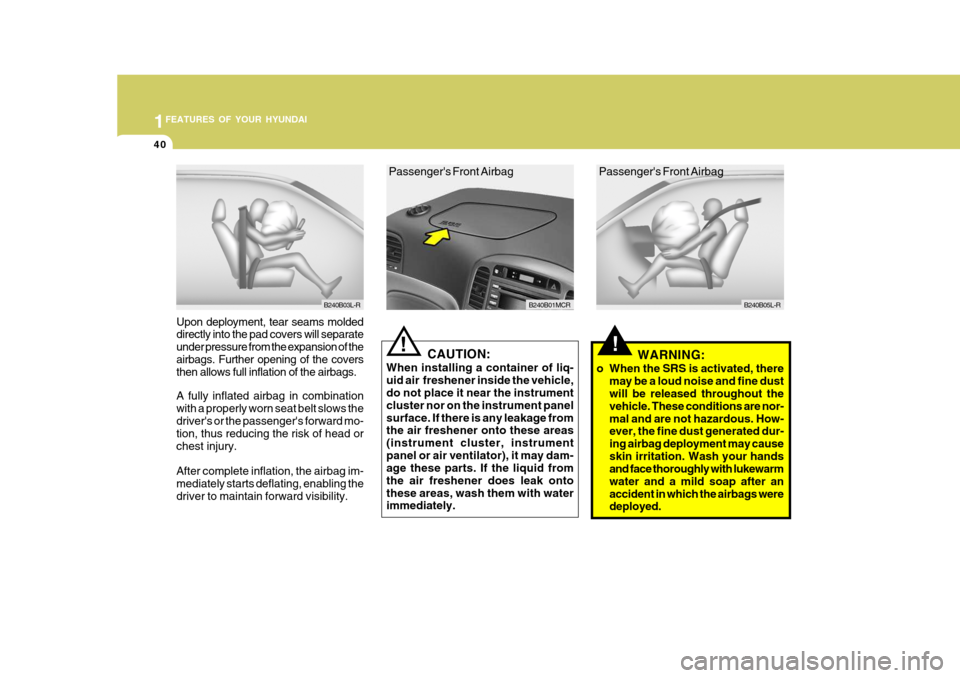
1FEATURES OF YOUR HYUNDAI
40
!!
Upon deployment, tear seams molded directly into the pad covers will separate under pressure from the expansion of theairbags. Further opening of the covers then allows full inflation of the airbags. A fully inflated airbag in combination with a properly worn seat belt slows thedriver's or the passenger's forward mo- tion, thus reducing the risk of head or chest injury. After complete inflation, the airbag im- mediately starts deflating, enabling thedriver to maintain forward visibility.
B240B03L-R
CAUTION:
When installing a container of liq- uid air freshener inside the vehicle, do not place it near the instrument cluster nor on the instrument panelsurface. If there is any leakage from the air freshener onto these areas (instrument cluster, instrumentpanel or air ventilator), it may dam- age these parts. If the liquid from the air freshener does leak ontothese areas, wash them with water immediately.B240B01MCR
Passenger's Front AirbagB240B05L-R
Passenger's Front Airbag
WARNING:
o When the SRS is activated, there may be a loud noise and fine dust will be released throughout the vehicle. These conditions are nor-mal and are not hazardous. How- ever, the fine dust generated dur- ing airbag deployment may causeskin irritation. Wash your hands and face thoroughly with lukewarm water and a mild soap after anaccident in which the airbags were deployed.
Page 148 of 232
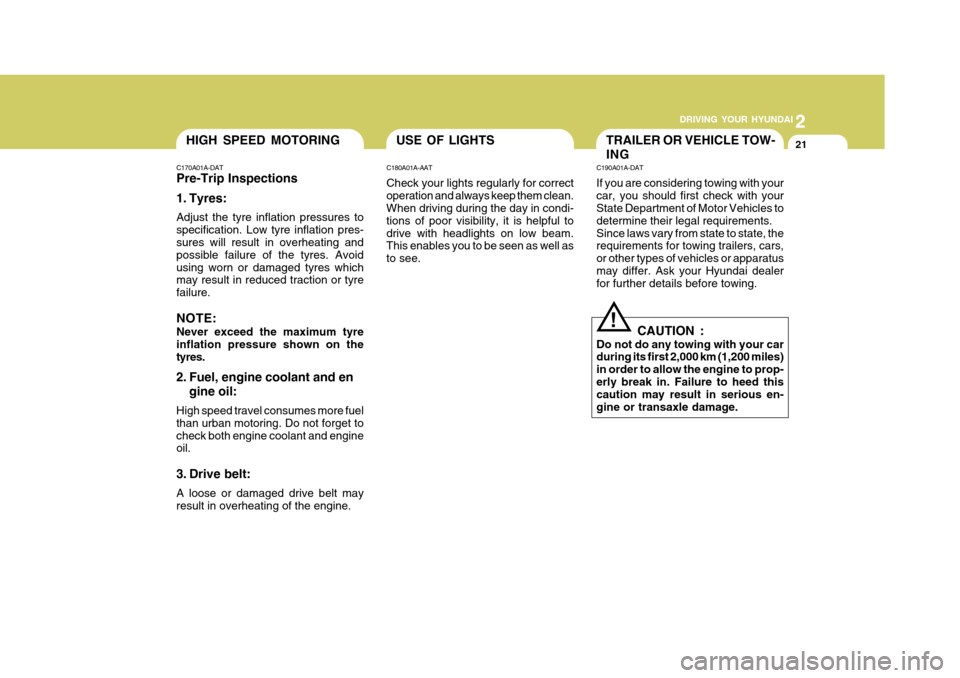
2
DRIVING YOUR HYUNDAI
21
2
DRIVING YOUR HYUNDAI
21USE OF LIGHTS
C180A01A-AAT Check your lights regularly for correct operation and always keep them clean. When driving during the day in condi- tions of poor visibility, it is helpful todrive with headlights on low beam. This enables you to be seen as well as to see.HIGH SPEED MOTORING
C170A01A-DAT Pre-Trip Inspections
1. Tyres: Adjust the tyre inflation pressures to specification. Low tyre inflation pres- sures will result in overheating and possible failure of the tyres. Avoidusing worn or damaged tyres which may result in reduced traction or tyre failure. NOTE: Never exceed the maximum tyre inflation pressure shown on the tyres.
2. Fuel, engine coolant and en gine oil:
High speed travel consumes more fuel than urban motoring. Do not forget tocheck both engine coolant and engine oil.
3. Drive belt: A loose or damaged drive belt may result in overheating of the engine.TRAILER OR VEHICLE TOW- ING
C190A01A-DAT If you are considering towing with your car, you should first check with your State Department of Motor Vehicles to determine their legal requirements.Since laws vary from state to state, the requirements for towing trailers, cars, or other types of vehicles or apparatusmay differ. Ask your Hyundai dealer for further details before towing.
! CAUTION :
Do not do any towing with your car during its first 2,000 km (1,200 miles) in order to allow the engine to prop-erly break in. Failure to heed this caution may result in serious en- gine or transaxle damage.
Page 157 of 232
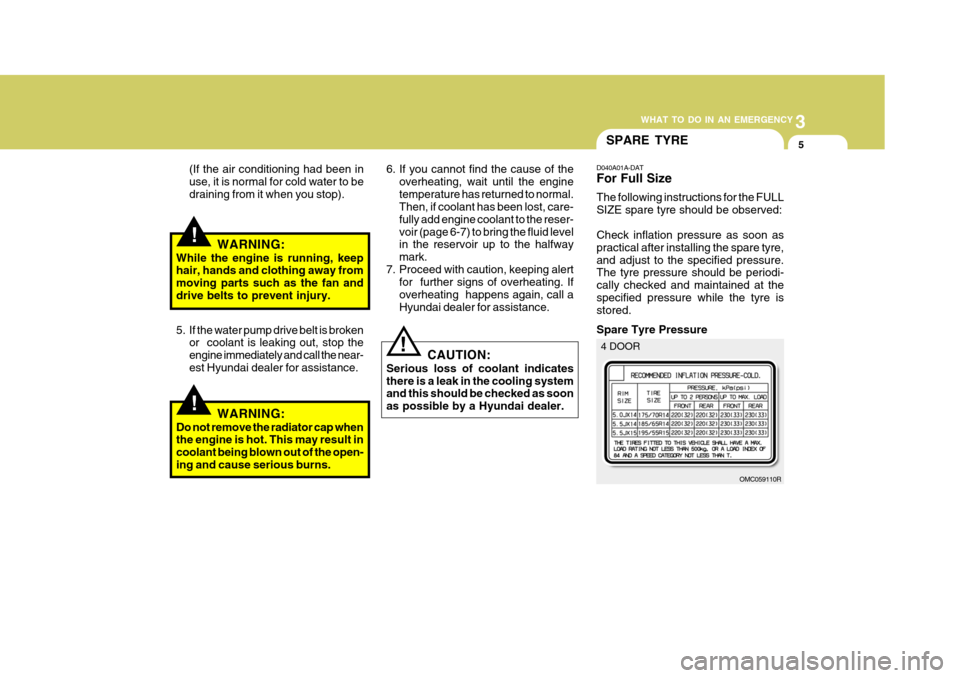
3
WHAT TO DO IN AN EMERGENCY
5
!
!
SPARE TYRE
(If the air conditioning had been in use, it is normal for cold water to bedraining from it when you stop).
WARNING:
While the engine is running, keep hair, hands and clothing away from moving parts such as the fan anddrive belts to prevent injury. 6. If you cannot find the cause of the
overheating, wait until the enginetemperature has returned to normal. Then, if coolant has been lost, care- fully add engine coolant to the reser-voir (page 6-7) to bring the fluid level in the reservoir up to the halfway mark.
7. Proceed with caution, keeping alert for further signs of overheating. Ifoverheating happens again, call aHyundai dealer for assistance.
5. If the water pump drive belt is broken or coolant is leaking out, stop theengine immediately and call the near-est Hyundai dealer for assistance.
WARNING:
Do not remove the radiator cap when the engine is hot. This may result in coolant being blown out of the open-ing and cause serious burns.
! CAUTION:
Serious loss of coolant indicates there is a leak in the cooling system and this should be checked as soon as possible by a Hyundai dealer. D040A01A-DAT For Full Size The following instructions for the FULL SIZE spare tyre should be observed: Check inflation pressure as soon as practical after installing the spare tyre,and adjust to the specified pressure. The tyre pressure should be periodi- cally checked and maintained at thespecified pressure while the tyre is stored. Spare Tyre Pressure
OMC059110R
4 DOOR
Page 217 of 232
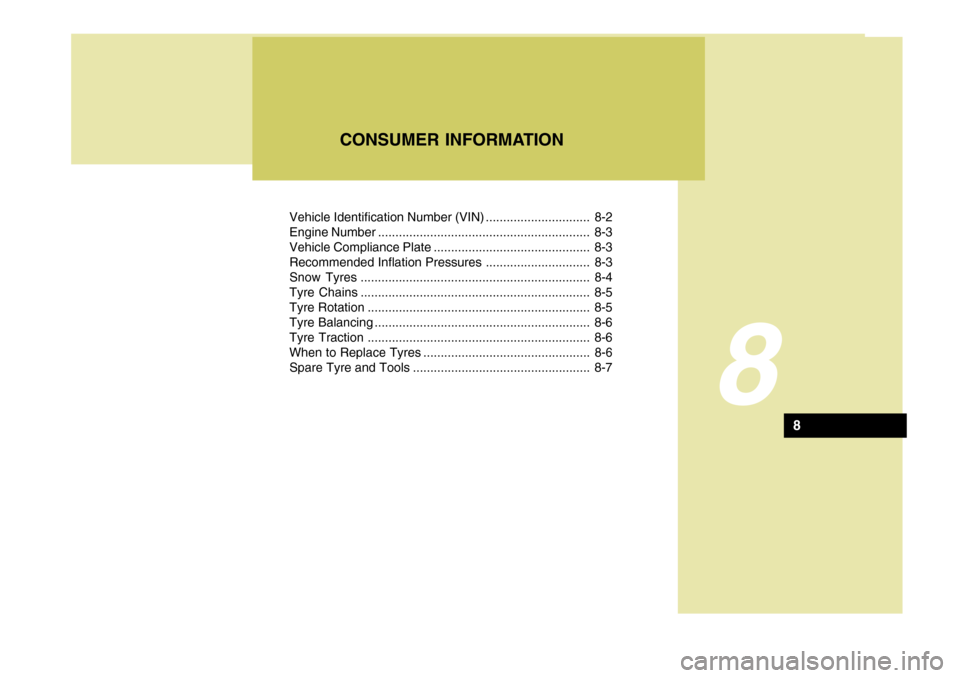
Vehicle Identification Number (VIN) .............................. 8-2
Engine Number ............................................................. 8-3
Vehicle Compliance Plate ............................................. 8-3
Recommended Inflation Pressures .............................. 8-3
Snow Tyres .................................................................. 8-4
Tyre Chains .................................................................. 8-5
Tyre Rotation ................................................................ 8-5
Tyre Balancing .............................................................. 8-6
Tyre Traction ................................................................ 8-6
When to Replace Tyres ................................................ 8-6
Spare Tyre and Tools ................................................... 8-7
8
CONSUMER INFORMATION
8
Page 219 of 232
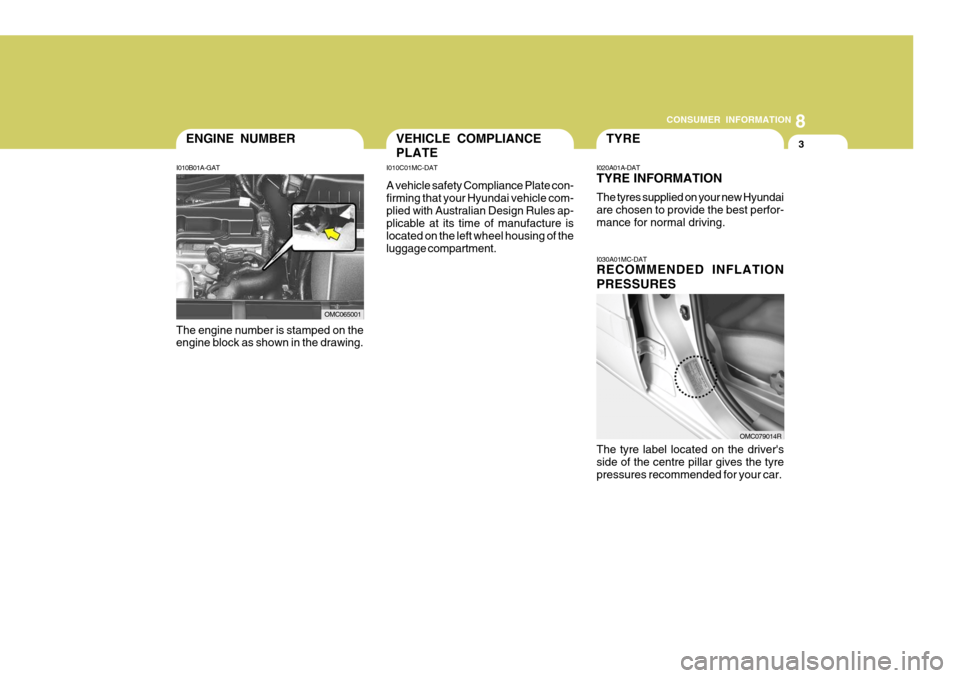
8
CONSUMER INFORMATION
3TYREVEHICLE COMPLIANCE PLATEENGINE NUMBER
I010B01A-GAT
The engine number is stamped on the engine block as shown in the drawing. I020A01A-DAT TYRE INFORMATION The tyres supplied on your new Hyundai are chosen to provide the best perfor-mance for normal driving.
I010C01MC-DAT A vehicle safety Compliance Plate con- firming that your Hyundai vehicle com-plied with Australian Design Rules ap- plicable at its time of manufacture is located on the left wheel housing of theluggage compartment.
I030A01MC-DAT RECOMMENDED INFLATION PRESSURES The tyre label located on the driver's side of the centre pillar gives the tyrepressures recommended for your car.
OMC065001
OMC079014R
Page 220 of 232
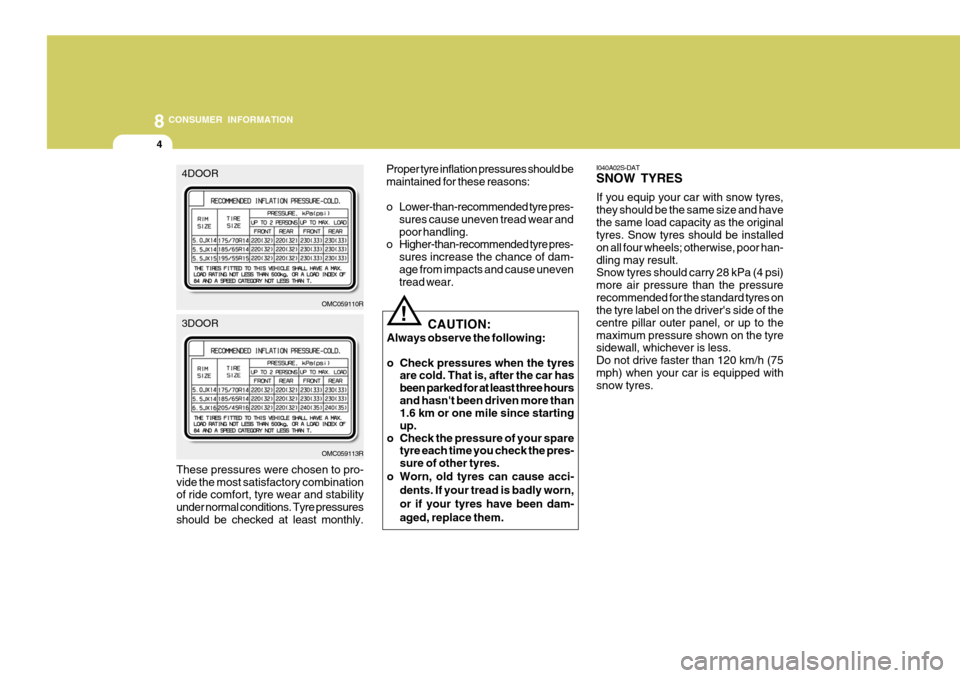
8CONSUMER INFORMATION
4
These pressures were chosen to pro- vide the most satisfactory combination of ride comfort, tyre wear and stability under normal conditions. Tyre pressuresshould be checked at least monthly. CAUTION:
Always observe the following:
o Check pressures when the tyres are cold. That is, after the car has been parked for at least three hoursand hasn't been driven more than 1.6 km or one mile since starting up.
o Check the pressure of your spare tyre each time you check the pres-sure of other tyres.
o Worn, old tyres can cause acci-
dents. If your tread is badly worn, or if your tyres have been dam-aged, replace them.
! I040A02S-DAT SNOW TYRES If you equip your car with snow tyres, they should be the same size and havethe same load capacity as the original tyres. Snow tyres should be installed on all four wheels; otherwise, poor han-dling may result. Snow tyres should carry 28 kPa (4 psi) more air pressure than the pressurerecommended for the standard tyres on the tyre label on the driver's side of the centre pillar outer panel, or up to themaximum pressure shown on the tyre sidewall, whichever is less. Do not drive faster than 120 km/h (75mph) when your car is equipped with snow tyres.
OMC059110R
OMC059113RProper tyre inflation pressures should be maintained for these reasons:
o Lower-than-recommended tyre pres-
sures cause uneven tread wear and poor handling.
o Higher-than-recommended tyre pres-
sures increase the chance of dam-age from impacts and cause uneven tread wear.
4DOOR 3DOOR